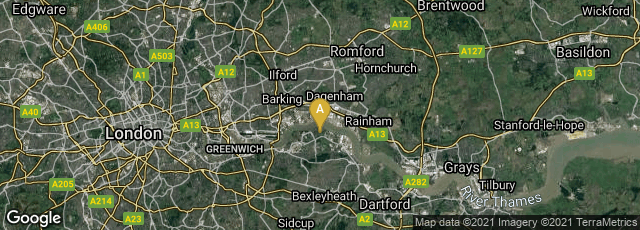
A: London, England, United Kingdom
Eyre & Spottiswoode Issue a Duo-Decimo Bible Bound in Gothic High Relief
1847

Jeremy Norman Collection of Images - Creative Commons
As mentioned in my annotation to this entry, what is most unusual about this binding is the survival of the fully relief spine. Until I purchased this binding I did not recall another binding of this type that included a fully relief spine in addition to the covers.
In 1847 the large industrial printing firm of Eyre & Spottiswood issued a duodecimo version of the bible printed in two columns in very small 6 point type, a format they called "Ruby 24mo." The cover panels measure 15 x 8 cm. What was most notable about the edition was its black papier mâché binding executed in the "monastic style" with raised borders on the front and rear covers with a central figure of a robed Jesus, right hand upraised, inside a series of Gothic arches; a lily plant is at Christ's feet with a single open bloom and two buds; acanthus motifs intertwined throughout. The spine panel contains a central acanthus plant with a single stem bearing a banner containing the words, "Holy Bible" near its head, and is within a single Gothic arch that forms the border of the spine panel. The three papier mâché panels are attached to a thinly pared leather under-binding; red, white and blue marbled eps; dentelles; all edges gilt with a diced diapered pattern with fluerons.
Invented during the Gothic Revival period and meant to imitate medieval woodcarving, papier-mâché binding panels were machine-made, using a plaster and antinomy mixture combined with or applied over papier-mâché, and then pressed over metal frames or into molds. The papier-mâché process was created by the English firm of Jackson & Sons, manufacturers of all kinds of interior and exterior ornamental relief work, and producers of architectural moldings for furniture, picture frames, wall panels, etc. The binding design was carved in a steel mold, into which was poured a mixture of plaster on a papier-mâché base. Once the papier-mâché were created, the actual binding process would have been undertaken by trade binders.
Since the relief panels were created by a mechanical process, but the book was bound by hand, we can say that elaborate bindings of this type were created by a combination of machinery and hand-craft. It is hard to imagine how much a binding of this type would have actually been used for reading. One assumes that it was more of a gift or display item. This copy does not show any obvious signs that it was ever read.
Due to the fragile nature of the hardened papier-mâché mixture, these books rarely survived intact. When I purchased this example in 2021 it was the first of these gothic bindings that I had seen on the market that included its original full relief papier-mâché spine intact. At some point in its history the copy had been recased skillfully with a new spine on which the original relief spine had been mounted. Other than a few cracks in the relief design’ inevitable in the few surviving examples of these bindings— this copy remains in remarkable condition.
This very distinctive binding was also used in 1848 on Eyre & Spottiswoode's production of The Book of Common Prayer.
Timeline Themes
